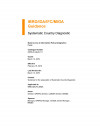The World Bank Group (WBG) conducts Systematic Country Diagnostics (SCDs) which contain useful information and data for the preparation of INFF-related assessment and diagnostics. The SCD aims to help the country, the WBG and other development partners establish a dialogue to focus their efforts around goals and activities that have high impact and are aligned with the global goals of ending absolute poverty and boosting shared prosperity in a sustainable manner.
The content of the SCD is context specific for any given country. However, each SCD incorporates the following set of themes or topics:
- Frames the issues/challenges with respect to achieving the country’s development goals in terms of the current trends and patterns in poverty reduction, inclusion and sustainability.
- Identifies the critical factors driving or constraining economic growth.
- Identifies the critical factors determining the inclusiveness of growth, namely increase in welfare of the poor and less well-off.
- Analyses the sustainability (environmental, social and fiscal) of the current pattern of
- growth, distribution and poverty reduction.
- Identifies, on the basis of the analyses under the previous points, a select set of priorities or focus areas for a country, in order to maximize its progress toward ending extreme poverty and promoting shared prosperity in a sustainable manner.
As part of the Country Engagement approach, SCDs are prepared by WBG staff in close consultation with a country’s national authorities and other stakeholders. Over 100 such diagnostics have been completed since 2014.
